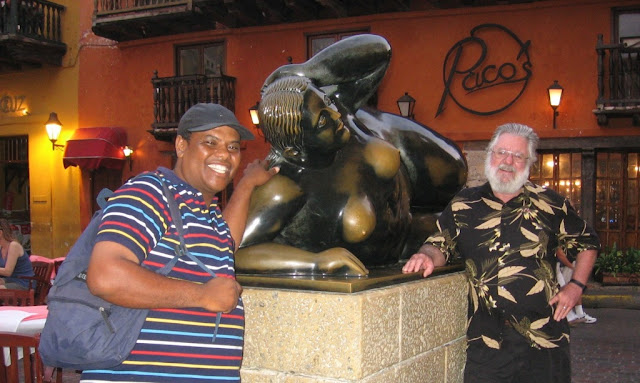We hadn't especially planned to go to Colombia, this year… the US state Department travel advisory is not hugely positive (“terrorist activity remains a threat…,” “marked increase in violent crime…,” US officials are forbidden to travel by city or regional bus, etc.) But Cartagena
So… in mid March we flew from Santiago to Bogotá in about 5 hours, then to Cartagena Old City
Today Cartagena is Colombia Old City
The old city, where strict rules maintain the colonial and republican period (post 1810) architecture, is a UNESCO World Heritage Site. Our hotel, Puertas de Cartagena (H on the map, left) near the plaza Fernandez de Madrid, was a republican era building with a lovely interior patio where breakfast was served.
We spent most days in the old city, walking the streets, admiring the architecture, seeing the attractions, shopping, eating and drinking (see “Eating Caribbean” on my other blog).
Leaving our hotel, we walked past the shady Plaza de Madrid….
toward the Plaza de la Aduana and the main gate to the old city.

The city’s major attractions are the Museum of the Inquisition, housed in a magnificent colonial era mansion. The major displays (of minimal interest) are replicas of inquisition instruments of torture and execution, with labels noting “not used in Cartagena," but the upstairs displays provide a reasonably good overview of the city’s history. The nearby Gold Museum is better, with artifacts from Colombia’s gold-working Zenú culture. There is also a modern art museum and an emerald museum.
But the most interesting, for the historically inclined, is the Naval Museum, with displays of the city’s history, fortifications and naval battles.
And it has great views looking toward the town center,
and toward the Caribbean and the wall.
One of the best experiences of the trip was a history and architectural tour by José Ramón. We met José at the Restaurant Alex, across from the Plaza de Madrid where his day job as a greeter is a great match for his friendly, outgoing personality. And as it turned out, he is an avid student of Cartagena
Colonial door decorations indicate the wealth and occupation of the owner. Here the door knocker (aldaba) below the iguana is a lion, representing a teacher. The iguana is simply a symbol for the knocker, from the Arabic dabbah, “lizard.”
He also took us to the Cartagena
And to the famous statue of La Gorda, by Colombian artist Fernando Botero.
Outside the walled old city a few blocks to the south is the largest Spanish fort in the Americas
La Chiva
In spite of the haze the view to the north, including the old city (center) and Bocagrande (left), was worth the visit.
Looking south, the teeming contemporary city.
And of course, Alejandra made a variety of friends on the city tour.
With these girls...
...and this sloth.
She also made friends in the city, here with Doña Angelina, a Palenquera (woman form Palenque , an Afro-Colombian community south of Cartagena
The other Cartagena Cartagena
Bocagrande from the bay side.
The beach is great for sunbathing and massages (see the tables?), but the sand is a bit silty and the water tends to be dingy from the river’s outflow.
We had massages. That was not our intent, but the charming palenqueras were so insistent that Alejandra was literally dragged to a chair where she was slathered with cream and massaged. So I let them take me too, and didn't spoil the fun by asking how much this was going to cost us.
Ten or fifteen amusing minutes later, banter and massage over, came the sticker shock: 160 – or maybe it was 320 - Colombian Bolivars, $80 or $160 US. And of course our charming masseuses were a bit less charming when it came to the money. I offered 32 Bolivars, which is what I had in my wallet, and eventually paid 62 ($31 US) after being accompanied to the ATM machine. I didn’t feel threatened – speaking Spanish and knowing what I was in for – but one might. Don’t let the nice ladies give you a massage unless you know the price in advance. And if you really want a massage, go to the folks down on the waterfront with the massage tables.
The other obligatory tourist excursion from Cartagena Cartagena
We went to a resort called Hotel Cocoliso, with a pleasant swimming area,
Snorkeling, canoe tours of the mangroves and trips to the islands’ aquarium and dolphin show are also available and lunch is included on most tours.
------------
1. As it turns out, Santiago Stuart was among nine martyrs for Colombian Independence executed in Cartagena Feb. 19, 1816 for disloyalty to the king of Spain and high treason. See Independencia de Cartagena in Spanish language Wilipedia.
1. As it turns out, Santiago Stuart was among nine martyrs for Colombian Independence executed in Cartagena Feb. 19, 1816 for disloyalty to the king of Spain and high treason. See Independencia de Cartagena in Spanish language Wilipedia.




































excelente resumen de esa entretenida semana.w.
ReplyDeleteGracias, Wifita.
ReplyDelete